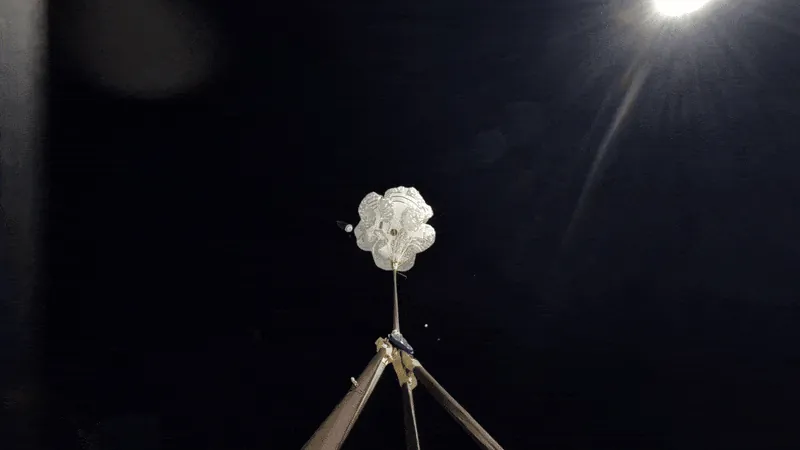
ExoMars Parachutes Set for Mars Mission with Groundbreaking Tests
2025-07-21
Author: Nur
Exciting Breakthrough in Mars Landing Technology!
In a remarkable achievement for space exploration, the ExoMars mission's parachute system has showcased its capability by successfully slowing down a mock landing platform, simulating a safe touchdown on Earth. This advanced system represents the most intricate parachute design ever prepared for deployment on the Martian surface.
High-Flying Trials in Arctic Conditions
On July 7, at the Esrange Space Center in northern Sweden, a helium balloon lifted a dummy descent module to an impressive altitude of nearly 30 kilometers. This drop paved the way for the deployment of two massive parachutes from their bags, mimicking the conditions the parachutes will face on Mars.
Luca Ferracina, ESA's ExoMars Entry Descent and Landing Module system engineer, expressed excitement about the parachute design, stating, "We are thrilled to confirm a system capable of functioning on Mars, featuring the largest parachute ever to be flown beyond Earth."
Simulating the Martian Atmosphere
To accurately replicate the thin Martian atmosphere—only 1% of Earth's density—these tests required the dummy capsule to plunge from a staggering height. The capsule entered free fall for about 20 seconds, reaching speeds close to the speed of sound before deploying its parachutes.
Luca elaborated, "The combination of velocity and low atmospheric density experienced in this test mirrors what we anticipate on Mars, providing confidence in the system's performance."
Innovations Make Mars Landing Safer
Landing on Mars is no small feat. The descent module must brake from a staggering 21,000 km/h to a gentle landing in just six minutes, safeguarding its precious payload: the Rosalind Franklin rover. This intricate process involves a sophisticated thermal shield, dual parachutes—each with its own pilot chute—and retro-rocket propulsion initiated moments before landing.
John Underwood, principal engineer at Vorticity, highlighted the advantages of using two parachutes, allowing for an efficient transition from supersonic to subsonic speeds.
Engineered to Perfection
The first main parachute measures 15 meters wide, taking inspiration from designs previously used in NASA’s Viking Mars missions. The second, a colossal 35 meters wide, incorporates a unique series of rings and gaps, making it the largest parachute ever to fly beyond Earth. Constructed from over 800 square meters of fabric and four kilometers of cord, the rigorous folding process takes up to three days.
Prepared for the Challenges Ahead
Although this parachute system was initially deemed ready for Mars back in 2021, its deployment was temporarily halted due to external circumstances. The recent test is a critical measure to ensure functionality after prolonged storage.
John remarked on the advantages of testing on Earth: "It allows us to capture extensive data and retrieve the parachutes for detailed inspection post-test."
A European Endeavor in Space Exploration
This ambitious project exemplifies European expertise, with components sourced from across the continent, including deployment mortars from the Netherlands and parachutes from Italy. Thales Alenia Space in France coordinated the test campaign, ensuring a collaborative effort in the pursuit of interplanetary exploration.
As we edge closer to the ExoMars mission, the successful testing of these advanced parachutes marks a significant milestone in our quest to unlock the mysteries of Mars.



 Brasil (PT)
Brasil (PT)
 Canada (EN)
Canada (EN)
 Chile (ES)
Chile (ES)
 Česko (CS)
Česko (CS)
 대한민국 (KO)
대한민국 (KO)
 España (ES)
España (ES)
 France (FR)
France (FR)
 Hong Kong (EN)
Hong Kong (EN)
 Italia (IT)
Italia (IT)
 日本 (JA)
日本 (JA)
 Magyarország (HU)
Magyarország (HU)
 Norge (NO)
Norge (NO)
 Polska (PL)
Polska (PL)
 Schweiz (DE)
Schweiz (DE)
 Singapore (EN)
Singapore (EN)
 Sverige (SV)
Sverige (SV)
 Suomi (FI)
Suomi (FI)
 Türkiye (TR)
Türkiye (TR)
 الإمارات العربية المتحدة (AR)
الإمارات العربية المتحدة (AR)